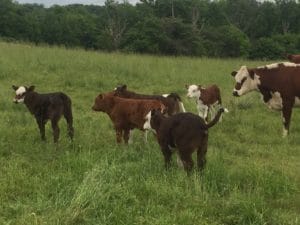The Green Lie of Hay and Grazing Lands: Deceivingly Green Pastures Performing at a Fraction of Their Potential
This article was featured in the Summer 2017 Quarterly.
by Rich Taber
At the time of this writing in early May, I look out the window onto a green, awakening landscape, with the sun trying to deliver its warm rays to kick start the green up process via photosynthesis. I think of those approaching warmer sunny summer days, and all of the hay I will be putting up for my livestock this coming year, and also grazing. I think of those beautiful green fields of pasture lands and hay lands that those grasses grow on, and of all the effort, inputs, and money it will take to keep them healthy and producing well.

Cattle grazing on pastureland. Often grazing lands are neglected, with no inputs being returned to the land.
In my work with many new and beginning farmers, I also think of “The Green Lie, Version Two.” “The Green Lie,” Version One, is a term coined by a forestry colleague of mine, that refers to woodlots that have been pillaged of all their good timber trees, leaving only stunted, weedy species growing, with no planning for the future and leaving behind a ravaged woodlot, and frequently with impeded or nonexistent regeneration of young tree seedlings. From a distance though, after such logging jobs occur, you can still see green trees growing, the birds are twittering, and all looks deceptively well; “The Green Lie” if you will. The woods are still there, right? In many peoples’ minds, when looking at such woodlots, all must be well. But wait, what’s all this about a “lie?” Hear me out!…
Read the rest of the article here.


great article, very useful information